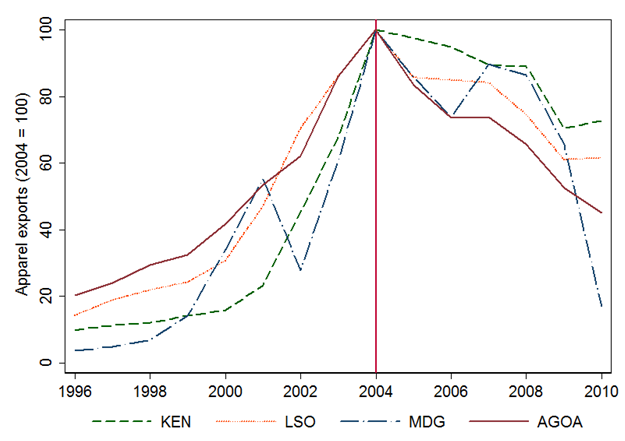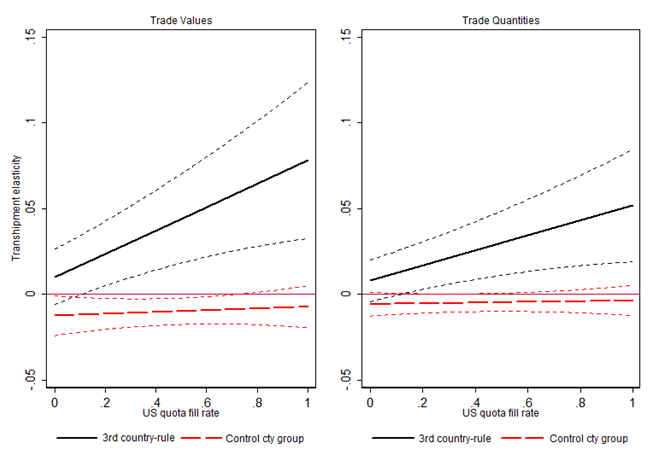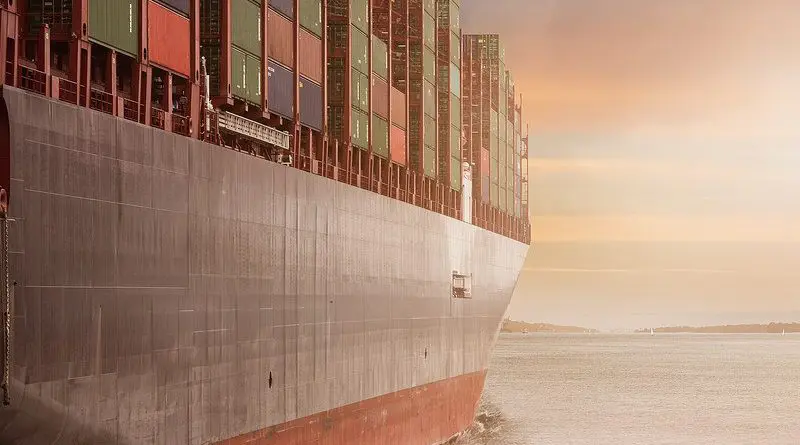The Rise And Fall Of (Chinese) African Apparel Exports – Analysis
By VoxEU.org
The surge in African apparel exports that followed the launch of new US trade preferences in 2000 gave hope that African industrialisation was around the corner. Ten years down the road, the success was all but forgotten. This column shows this is because US trade policies inadvertently turned Africa into a temporary trade corridor for China.
By Lorenzo Rotunno, Pierre-Louis Vézina and Zheng Wang
Even the tiniest signs of industrial take-off in Africa always attract the attention of economists and policymakers, both of whom are eagerly awaiting the elusive African growth miracle. One such episode of excitement was the surge of apparel exports that followed the implementation of the African Growth and Opportunity Act (AGOA) by the US in October 2000.
AGOA, which enabled some African countries to export over 4,000 products, including hundreds of apparel products, quota-free and duty-free to the US, is widely regarded as a trade policy success. For example, Collier and Venables (2007a, 2007b) and Frazer and Van Biesebroeck (2010) both argue AGOA had a significant impact on exports to the US, especially for apparel products. Yet the export surge has not survived the 2005 demise of the Multifibre Agreement, when Chinese exports, no longer facing US quotas, took over (Harrigan and Barrows 2009), and has not been accompanied by dynamic growth benefits (Edwards and Lawrence 2010). As seen in Figure 1, exports from AGOA’s three most successful exporters as well as AGOA as a whole peaked in 2004 and it was all downhill after that.

In recent research (Rotunno et al. 2012) we argue the success was rapid but short lived, as a large share of AGOA exports were in fact Chinese exports transhipped through AGOA to circumvent now-abolished US quotas and on top benefit from duty-free treatment.
How US trade polices inadvertently turned Africa into a trade corridor for China
As pointed out by Brambilla et al. (2010), the quotas imposed on Chinese exports during the Multifibre Agreement guaranteed smaller developing countries access to the US market. This implicit export subsidy for African countries, coupled with AGOA preferences, was thus a golden opportunity for African apparel exporters.
Yet, a key feature of the AGOA preferences was the absence of rules of origin, which are usually imposed under trade agreements to avoid transhipment. This meant that African exporters could use inputs from any country, in any proportion, as long as some assembly work took place in Africa1. It therefore provided an opportunity for Chinese exporters to merely tranship their products via ‘screwdriver plants’ in Africa, avoiding US quotas and on top benefiting from AGOA preferences. The end of the quotas on Chinese exports rendered the transhipment unnecessary, leading to the departure of footloose factories and the fall of AGOA exports.
The Chinese wave in Africa
The suspicion that AGOA and US quotas on Chinese exports spurred a Chinese manufacturing wave in Africa has been documented by a recent literature as well as news reports. According to Naumann (2008), Chinese and Taiwanese producers formed the bulk of a textile ‘diaspora’ in Lesotho, Madagascar, and Kenya, which have seen a revival of their sectors owing to these foreign investments. Rolfe and Woodward (2005) find that, in the Kenyan Export Processing Zone, 80% of the 34 garment plants had Asian owners. Traub-Merz (2006) and Zafar (2007) note that Chinese factories in several African countries had been set up to take advantage of easy African access to the US market under AGOA and that exports have been concentrated in formerly quota-restrained products, such as basic trousers, t-shirts, and sweaters.
What’s more, a large number of papers emphasise that the inputs of apparel firms in Africa were usually Chinese. Voest (2012) documents that the Taiwanese clothing firms in Lesotho imported 93% of material input from network sources in Asia where China constitutes the major supplier. Edwards and Lawrence (2010) describe the experience of Lesotho firms which, “provide assembly, packaging and shipping services and depend on their Asian headquarters to generate orders, design the clothes, and send them the fabric they need”.
Tracing transhipment
We go further than the anecdotal evidence by empirically tracing the transhipment from China to the US via Africa. More precisely, we show that Chinese apparel exports to AGOA countries predict these countries exports to the US. To show that this correlation, which we label transhipment elasticity, indeed captures transhipment, we show it only holds in countries which didn’t face any rules of origin within AGOA, and only for products bound by US quotas on Chinese exports. In other words we find traces of transhipment only where incentives were highest, i.e. in quota-bound products, and in countries where it was legally possible to do so.
This is illustrated in Figure 2 which shows how the transhipment elasticity varies with the quota fill rates, a measure quota bindingness, and across countries. In countries not facing any rules of origin, i.e. where transhipment was possible, we find a positive elasticity that increases significantly with the bindingness of the quotas (blue line). But in AGOA countries ineligible for the apparel provision, or in those facing rules of origin, such as in apparel-exporting South Africa and Mauritius, we find no significant transhipment elasticity (red line).

Policy implications
In a nutshell, our research provides evidence on the unintended consequences of economic policies, here the transhipment that resulted from the combination of US quotas against China and preferences for Africa. This transhipment explains the surprisingly fast and robust impact AGOA had on apparel exports to the US. Back-of-the-envelope calculations suggest that the policy combination may account for as much as 64% of Botswana’s apparel exports, 45% of Kenya’s, 35% of Madagascar’s, and 23% of Lesotho’s. As Collier and Venables (2007), we highlight that the absence of rules of origin was key to the opening of factories in Africa, as Chinese production could fragment to take advantage of favourable trade preferences.
Yet this rapid rise and fall confirms the prediction of Baldwin (2011), namely that supply-chain industrialisation may lead to fast growth but can have limited spillovers and comes with the risk of further relocations of production. Development-focused trade policies should thus pay special attention to the fickleness of production fragmentation.
Authors:
Lorenzo Rotunno, PhD student in International Economics, Graduate Institute, Geneva
Pierre-Louis Vézina, Research Fellow, OxCarre
Zheng Wang, Assistant Professor in Economics at the University of Nottingham China Campus
References
Baldwin, R (2011), Trade and Industrialisation After Globalisation’s 2nd Unbundling: How Building and Joining A Supply Chain Are Different and Why It Matters. NBER Working Paper 17716
Brambilla, I, A K Khandelwal and P K Schott (2010), China’s experience under the Multi-Fiber Arrangement (MFA) and the Agreement on Textiles and Clothing (ATC), in: Feenstra, R., Wei, S.J. (Eds.), China’s Growing Role in World Trade. University of Chicago Press, Chicago
Collier, P and A J Venables (2007a), “Rethinking trade preferences: How Africa can diversify its exports”, The World Economy.
Collier, P and A J Venables (2007b), “Rethinking trade preferences: How Africa can diversify its exports” VoxEU.org, 28 May.
Edwards, L and R Z Lawrence (2010), “AGOA Rules: The Intended and Unintended Consequences of Special Fabric Provisions”, NBER Working Paper 16623
Frazer, G and J Van Biesebroeck (2010), “Trade growth under the African Growth and Opportunity Act”, The Review of Economics and Statistics
Harrigan, J and G Barrows (2009) “Testing the theory of trade policy: evidence from the abrupt end of the Multifiber Arrangement”, The Review of Economics and Statistics.
Naumann, E (2008) T”he Multifibre Agreement-WTO Agreement on Textiles and Clothing”, Tralac Working Paper 4
Rolfe, R J and D P Woodward, (2005), “African apparel exports, AGOA, and the trade preference illusion”, Global Economy Journal.
Rotunno, L, P-L Vézina and Z Wang (2012), “The rise and fall of (Chinese) African apparel exports”, CSAE Working Paper 2012-12
Traub-Merz, R (2006), “The African textile and clothing industry: from import substitution to export orientation”, in Jauch, H and R Traub-Merz (eds.), The Future of the Textile and Clothing Industry in Sub-Saharan Africa, Friedrich-Ebert-Stiftung
Voest, J A D (2012), “Extension of Time for Imports of Textiles from Outside the AGOA Region”, mimeo.
Zafar, A (2007), “The growing relationship between China and Sub-Saharan Africa: macroeconomic, trade, investment, and aid links”, The World Bank Research Observer.
1 Not all countries eligible for AGOA were eligible for the Apparel provision, which extended the preferences to apparel products. Furthermore, among Apparel-eligible countries, only less-developed countries faced no rules of origin.

